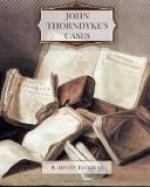“On the platform here he met Miss Grant, who had come down from London, and was going on to Worthing. They entered the branch train together, having a first-class compartment to themselves. It seems she was wearing his locket at the time, and he made another appeal to her to make an exchange, which she refused, as before. The discussion appears to have become rather heated and angry on both sides, for the guard and a porter at Munsden both noticed that they seemed to be quarrelling; but the upshot of the affair was that the lady snapped the chain, and tossed it together with the locket to my brother, and they parted quite amiably at Shinglehurst, where Harold got out. He was then carrying his full sketching kit, including a large holland umbrella, the lower joint of which is an ash staff fitted with a powerful steel spike for driving into the ground.
“It was about half-past ten when he got out at Shinglehurst; by eleven he had reached his pitch and got to work, and he painted steadily for three hours. Then he packed up his traps, and was just starting on his way back to the station, when he was met by the police and arrested.
“And now, observe the accumulation of circumstantial evidence against him. He was the last person seen in company with the murdered woman—for no one seems to have seen her after they left Munsden; he appeared to be quarrelling with her when she was last seen alive, he had a reason for possibly wishing for her death, he was provided with an implement—a spiked staff—capable of inflicting the injury which caused her death, and, when he was searched, there was found in his possession the locket and broken chain, apparently removed from her person with violence.
“Against all this is, of course, his known character—he is the gentlest and most amiable of men—and his subsequent conduct—imbecile to the last degree if he had been guilty; but, as a lawyer, I can’t help seeing that appearances are almost hopelessly against him.”
“We won’t say ‘hopelessly,’” replied Thorndyke, as we took our places in the carriage, “though I expect the police are pretty cocksure. When does the inquest open?”
“To-day at four. I have obtained an order from the coroner for you to examine the body and be present at the post-mortem.”
“Do you happen to know the exact position of the wound?”
“Yes; it is a little above and behind the left ear—a horrible round hole, with a ragged cut or tear running from it to the side of the forehead.”
“And how was the body lying?”
“Right along the floor, with the feet close to the off-side door.”
“Was the wound on the head the only one?”
“No; there was a long cut or bruise on the right cheek—a contused wound the police surgeon called it, which he believes to have been inflicted with a heavy and rather blunt weapon. I have not heard of any other wounds or bruises.”




